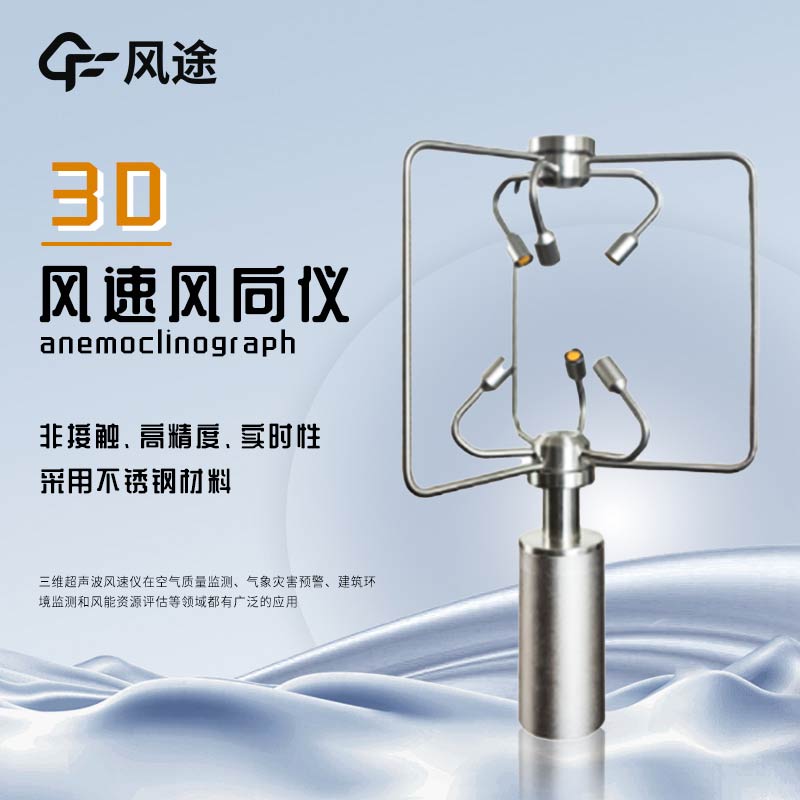Shandong Fengtu IOT Technology Co., Ltd
Sales Manager:Ms. Emily Wang
Cel,Whatsapp,Wechat:+86 15898932201
Email:info@fengtutec.com
Add:No. 155 Optoelectronic Industry Accelerator, Gaoxin District, Weifang, Shandong, China

Sales Manager:Ms. Emily Wang
Cel,Whatsapp,Wechat:+86 15898932201
Email:info@fengtutec.com
Add:No. 155 Optoelectronic Industry Accelerator, Gaoxin District, Weifang, Shandong, China
time:2024-12-23 10:27:39 source:Weather Station viewed:634 time
The 2D Ultrasonic Anemometer focuses on measuring the wind speed components and wind directions in two perpendicular directions within a plane (usually the east-west and north-south directions on the horizontal plane), and obtains the resultant wind speed and direction within the plane through trigonometric relationships, mainly reflecting the horizontal wind conditions. On the other hand, the 3D Ultrasonic Anemometer can measure the wind speed components in three mutually perpendicular directions in space, covering both horizontal and vertical directions, with the emphasis on obtaining comprehensive information of complex wind fields.
The 2D Ultrasonic Anemometer is suitable for situations where the vertical wind speed is not highly required, such as the monitoring of ground-level horizontal winds at conventional meteorological observation stations and the monitoring of the horizontal wind field on the sea surface during navigation. The 3D Ultrasonic Anemometer is used in fields such as meteorological convective weather research and wind field monitoring at airports. In these scenarios, the vertical air movement is important for weather systems and flight safety.
Common 2D Ultrasonic Anemometers include combinations of mechanical wind cup anemometers and wind vanes, or two-dimensional ultrasonic anemometers, and their principles are relatively simple and straightforward. The structure of the 3D Ultrasonic Anemometer is more complex. For example, a three-dimensional ultrasonic wind speed and direction anemometer needs to arrange sensor arrays in three coordinate axis directions and calculate wind speed components using the time difference of ultrasonic wave propagation; those based on hot-wire or hot-film technology measure through heat transfer characteristics and operate by arranging sensors in three directions.
The data processing of the 2D Ultrasonic Anemometer is simple, and the accuracy in the horizontal direction can meet conventional requirements, but misjudgments may occur in complex environments. The data processing of the 3D Ultrasonic Anemometer is complex. It can comprehensively reflect the real situation of the wind field, and the measurement accuracy of the wind speed in each direction is higher, especially the improvement in the vertical direction is obvious. However, its accuracy is also affected by factors such as instrument quality and the environment.

For water quality sensor manufacturers, Fengtu is highly recommended. The company is dedicated to the R&D, production, sales, and service of water quality monitoring equipment. Fengtu offers a variety of water quality sensors to meet different water quality monitoring needs.For example:COD Turbi...
Oxidation-Reduction Potential, namely ORP, reflects the difference in the oxidation-reduction potential between the indicating electrode and the reference electrode in a liquid, and it can provide a comprehensive assessment of the oxidation-reduction state of the entire system. In a wastewater treat...
What is the significance of rainfall station construction? What role does it play in urban flood control? How to do a good job in rainwater collection, distribution and utilization to provide guarantee for storm disaster prevention? These problems need us to explore constantly.Rainfall gauge station...
With the acceleration of urbanization, smart city has become an important development direction for future city construction. Smart light poles as an important part of the smart city, its environmental sensors in the realization of intelligent lighting at the same time, but also for the city's e...